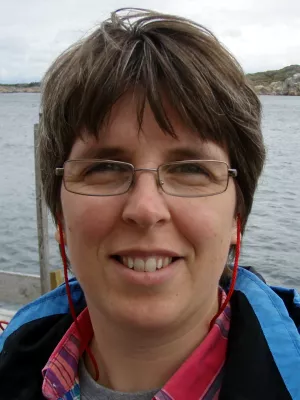
Helena Alexanderson
Professor

Inland dunes and cover sand in southern Sweden and Norway – evidence of late glacial and historical aeolian activity
Author
Summary, in English
Aeolian deposits in Sweden and Norway are poorly explored as environmental records. Many, mainly small, occurrences of windblown sand have been mapped, but few have been investigated in any detail and even fewer have been absolutely dated. Here we present results from a project aiming to determine the timing and magnitude of wind activity in inland settings in southern Sweden and Norway and to better understand the aeolian impact on the landscape.
By the end of this year, four areas will have been investigated: three inland dune fields (Bonäsheden, Brattforsheden, Starmoen) and one cover sand site (Blentarp). Our work includes geomorphological mapping, sedimentological and stratigraphic studies, ground penetrating radar investigations, and luminescence and radiocarbon dating.
Aeolian sand is in most areas found on top of glaciofluvial sediments that were deposited during deglaciation. Cover sand is generally thin, but can reach 1-2 m thickness in depressions and may contain palaeosols. Most dunes are transverse, and can be used to infer palaeowind directions.
Luminescence dating shows that the first aeolian deposition took place during or right after deglaciation, and that the main part of the sand was deposited within a few thousand years after deglaciation. This confirms the supposed deglaciation age of the oldest aeolian deposits based mainly on their geomorphological context. In at least two of the areas (Brattforsheden and Blentarp), aeolian sand has been reactivated at least once during historical times (<500 years ago). This is likely mainly due to human impact, such as expansion of agriculture or mining.
By the end of this year, four areas will have been investigated: three inland dune fields (Bonäsheden, Brattforsheden, Starmoen) and one cover sand site (Blentarp). Our work includes geomorphological mapping, sedimentological and stratigraphic studies, ground penetrating radar investigations, and luminescence and radiocarbon dating.
Aeolian sand is in most areas found on top of glaciofluvial sediments that were deposited during deglaciation. Cover sand is generally thin, but can reach 1-2 m thickness in depressions and may contain palaeosols. Most dunes are transverse, and can be used to infer palaeowind directions.
Luminescence dating shows that the first aeolian deposition took place during or right after deglaciation, and that the main part of the sand was deposited within a few thousand years after deglaciation. This confirms the supposed deglaciation age of the oldest aeolian deposits based mainly on their geomorphological context. In at least two of the areas (Brattforsheden and Blentarp), aeolian sand has been reactivated at least once during historical times (<500 years ago). This is likely mainly due to human impact, such as expansion of agriculture or mining.
Department/s
- Quaternary Sciences
Publishing year
2014
Language
English
Pages
148-148
Links
Document type
Conference paper: abstract
Topic
- Geology
Conference name
31st Nordic Geological Winter Meeting, 2014
Conference date
2014-01-08 - 2014-01-10
Conference place
Lund, Sweden
Status
Published
Project
- Aeolian activity in Sweden: an unexplored environmental archive

